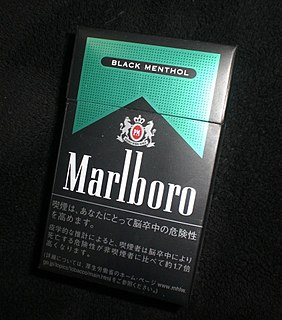
Listerine is an American brand of antiseptic mouthwash that is promoted with the slogan "Kills germs that cause bad breath", Named after Joseph Lister, who pioneered antiseptic surgery at the Glasgow Royal Infirmary in Scotland, Listerine was developed in 1879 by Joseph Lawrence, a chemist in St. Louis, Missouri.

Peppermint is a hybrid mint, a cross between watermint and spearmint. Indigenous to Europe and the Middle East, the plant is now widely spread and cultivated in many regions of the world. It is occasionally found in the wild with its parent species.

Menthol is an organic compound, more specifically a monoterpenoid, made synthetically or obtained from the oils of corn mint, peppermint, or other mints. It is a waxy, crystalline substance, clear or white in color, which is solid at room temperature and melts slightly above.

Kool is an American brand of menthol cigarette, currently owned and manufactured by ITG Brands LLC, a subsidiary of Imperial Tobacco Company. Kool cigarettes sold outside of the United States are manufactured by British American Tobacco.
A thermoreceptor is a non-specialised sense receptor, or more accurately the receptive portion of a sensory neuron, that codes absolute and relative changes in temperature, primarily within the innocuous range. In the mammalian peripheral nervous system, warmth receptors are thought to be unmyelinated C-fibres, while those responding to cold have both C-fibers and thinly myelinated A delta fibers. The adequate stimulus for a warm receptor is warming, which results in an increase in their action potential discharge rate. Cooling results in a decrease in warm receptor discharge rate. For cold receptors their firing rate increases during cooling and decreases during warming. Some cold receptors also respond with a brief action potential discharge to high temperatures, i.e. typically above 45 °C, and this is known as a paradoxical response to heat. The mechanism responsible for this behavior has not been determined.

Miliaria, also called sweat rash, is a skin disease marked by small, itchy rashes due to sweat trapped under the skin by clogged sweat-gland ducts. Miliaria is a common ailment in hot and humid conditions, such as in the tropics and during the summer. Although it affects people of all ages, it is especially common in children and infants due to their underdeveloped sweat glands.

Kretek are unfiltered cigarettes of Indonesian origin, made with a blend of tobacco, cloves, and other flavors. The word "kretek" itself is an onomatopoetic term for the crackling sound of burning cloves.

L&M is an American brand of cigarettes, currently owned and manufactured by Altria and Philip Morris International. The name comes from the tobacco company founded in 1873 called Liggett & Myers, predecessor of today's Liggett Group, in which L&M was originally produced.

Halls is the brand name of a popular mentholated cough drop. Halls cough drops are sold by the Cadbury-Adams Division of Cadbury, now owned by Mondelēz International, and have long been advertised as featuring "Vapour Action".

Shower gel is a specialized liquid product used for cleaning the body during showers. Not to be confused with liquid soaps, shower gels, in fact, do not contain saponified oil. Instead, it uses synthetic detergents derived from either petroleum or plant sources.
Monoterpenes are a class of terpenes that consist of two isoprene units and have the molecular formula C10H16. Monoterpenes may be linear (acyclic) or contain rings (monocyclic and bicyclic). Modified terpenes, such as those containing oxygen functionality or missing a methyl group, are called monoterpenoids. Monoterpenes and monoterpenoids are diverse. They have relevance to the pharmaceutical, cosmetic, agricultural, and food industries.

A menthol cigarette is a cigarette flavored with the compound menthol.

Transient receptor potential cation channel subfamily M (melastatin) member 8 (TRPM8), also known as the cold and menthol receptor 1 (CMR1), is a protein that in humans is encoded by the TRPM8 gene. The TRPM8 channel is the primary molecular transducer of cold somatosensation in humans. In addition, mints can desensitize a region through the activation of TRPM8 receptors.
In enzymology, a (−)-menthol monooxygenase (EC 1.14.13.46) is an enzyme that catalyzes the chemical reaction

p-Menthane-3,8-diol, also known as para-menthane-3,8-diol, PMD, or menthoglycol, is an organic compound classified as a diol and a terpenoid. It is colorless. Its name reflects the hydrocarbon backbone, which is that of p-menthane. A total of eight stereoisomers are possible, based on the three stereocenters of the ring. Depending on the source, one or more may predominate.

Menthoxypropanediol, is a synthetic derivative of menthol. While the cooling strength of 3-(l-menthoxy)propane-1,2-diol is accepted as being about 20–25% that of menthol, it is also noted that "in a Vaseline ointment, 3-(l-menthoxy)propane-1,2-diol shows a cool feeling 2.0 to 2.5 times stronger than that of l-menthol". It is used in various cosmetic chemical concoctions.

Ironing is the use of a machine, usually a heated tool, to remove wrinkles from fabric. The heating is commonly done to a temperature of 180–220 °Celsius, depending on the fabric. Ironing works by loosening the bonds between the long-chain polymer molecules in the fibers of the material. While the molecules are hot, the fibers are straightened by the weight of the iron, and they hold their new shape as they cool. Some fabrics, such as cotton, require the addition of water to loosen the intermolecular bonds. Many modern fabrics are advertised as needing little or no ironing. Permanent press clothing was developed to reduce the ironing necessary by combining wrinkle-resistant polyester with cotton.
Tobacco marketing targeting African-Americans refers to the practice of customizing tobacco products and advertising techniques specifically to African-American consumers. It is most commonly analyzed through the consumption of mentholated cigarettes, as it represents 47% of black adult smokers and 84% of adolescent black smokers.

VP, also known as EA-1511, is an extremely toxic organophosphate nerve agent of the V-series.

WS-12 is a chemical compound that acts as a potent and selective activator of the TRPM8 calcium channel, which is responsible for the sensation of coldness produced by menthol. It is slightly less potent as a TRPM8 activator compared to icilin, but is much more selective for TRPM8 over related calcium channels. It produces analgesic and antiinflammatory effects in animal models with similar efficacy to menthol and a reduced side effect profile.
















